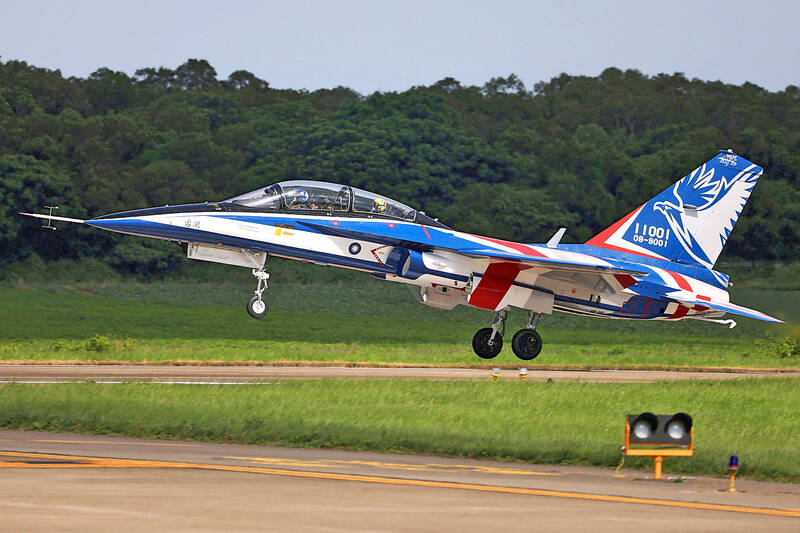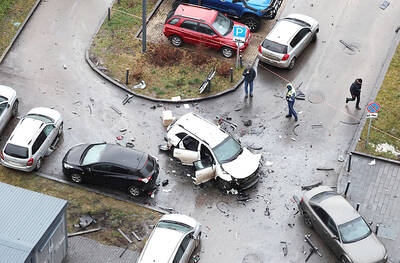The air force has grounded all training jets after an aircraft crashed yesterday due to “dual engine failure,” with the pilot ejecting safely.
The domestically built AT-5 Yung Ying (勇鷹, “Brave Eagle”) advanced jet trainer went down at 8:40am during a training exercise after taking off from Chihhang Air Base in southern Taitung County, the air force said in a statement.
The sole occupant of the two-seater jet trainer, air force Major-in-Training Lin Wei (林瑋), ejected and parachuted to safety after both aircraft’s engines failed, it said.

Photo: Ann Wang, Reuters
The 34-year-old Lin displayed mild signs of hypothermia following his rescue and was under observation at Mackay Memorial Hospital’s Taitung branch, doctors said.
Lin’s jet had recorded 183 hours of flight time prior to yesterday, the air force said.
Lin graduated from the Air Force Academy and had clocked a total flight time of 1,184 hours before the crash.
The air force said the jet had “dual engine failure,” but a special task force would investigate “to clarify the cause and ensure training safety.”
Yesterday’s incident was the first time a Brave Eagle had an accident since the air force began receiving the planes from Aerospace Industrial Development Corp (AIDC, 漢翔航空) in 2021 to replace its aging AT-3 jet trainers.
AIDC has delivered 41 out of 66 Brave Eagles ordered by the air force. The remaining aircraft are scheduled to be delivered by the end of next year.
Yesterday’s crash could be a setback for air force plans to replace the aging AT-3 fleet before the end of next year, sources said.
The armed forces are mostly equipped by the US, but the government has made the development of an advanced homegrown defence industry a priority, especially as China steps up military modernization efforts and drills near Taiwan.
In February 2017, the Ministry of National Defense initiated the development of the Advanced Trainer Jet program. The aircraft received the name “Brave Eagle” in September 2019 when the first prototype rolled off the assembly line.
The first AT-5 flight was in June 2020 and AIDC delivered the first sample of the mass-production model in November 2021.
The AT-5 is Taiwan’s first domestically made since the F-CK-1 Ching-kuo Indigenous Defence Fighter, or IDF, rolled out more than three decades ago. The two jets look similar and have similar capabilities.
Despite AT-5’s external resemblance to the F-CK-1 air superiority fighter — a deliberate design choice to replicate the latter’s drag and angle of attack — 80 percent of the former’s components are different.
Significantly, the AT-5 uses a pair of AIDC/ITEC F124-200TW engines which feature lightweight composite materials, with 55 percent of parts sourced in Taiwan.
The AT-5 wings were modified to enable low-speed landing and stability at low airspeeds, desirable attributes for training.
The plane is designed to have a support function in times of war. It can be equipped with weapons, but that function remains in the testing phase.

TRAGEDY STRIKES TAIPEI: The suspect died after falling off a building after he threw smoke grenades into Taipei Main Station and went on a killing spree in Zhongshan A 27-year-old suspect allegedly threw smoke grenades in Taipei Main Station and then proceeded to Zhongshan MRT Station in a random killing spree that resulted in the death of the suspect and two other civilians, and seven injured, including one in critical condition, as of press time last night. The suspect, identified as a man surnamed Chang Wen (張文), allegedly began the attack at Taipei Main Station, the Taipei Fire Department said, adding that it received a report at 5:24pm that smoke grenades had been thrown in the station. One man in his 50s was rushed to hospital after a cardiac arrest

SAFETY FIRST: Double the number of police were deployed at the Taipei Marathon, while other cities released plans to bolster public event safety Authorities across Taiwan have stepped up security measures ahead of Christmas and New Year events, following a knife and smoke bomb attack in Taipei on Friday that left four people dead and 11 injured. In a bid to prevent potential copycat incidents, police deployments have been expanded for large gatherings, transport hubs, and other crowded public spaces, according to official statements from police and city authorities. Taipei Mayor Chiang Wan-an (蔣萬安) said the city has “comprehensively raised security readiness” in crowded areas, increased police deployments with armed officers, and intensified patrols during weekends and nighttime hours. For large-scale events, security checkpoints and explosives

PUBLIC SAFETY: The premier said that security would be tightened in transport hubs, while President Lai commended the public for their bravery The government is to deploy more police, including rapid response units, in crowded public areas to ensure a swift response to any threats, President William Lai (賴清德) said yesterday after a knife attack killed three people and injured 11 in Taipei the previous day. Lai made the remarks following a briefing by the National Police Agency on the progress of the investigation, saying that the attack underscored the importance of cooperation in public security between the central and local governments. The attack unfolded in the early evening on Friday around Taipei Main Station’s M7 exit and later near the Taipei MRT’s Zhongshan

A car bomb killed a senior Russian general in southern Moscow yesterday morning, the latest high-profile army figure to be blown up in a blast that came just hours after Russian and Ukrainian delegates held separate talks in Miami on a plan to end the war. Kyiv has not commented on the incident, but Russian investigators said they were probing whether the blast was “linked” to “Ukrainian special forces.” The attack was similar to other assassinations of generals and pro-war figures that have either been claimed, or are widely believed to have been orchestrated, by Ukraine. Russian Lieutenant General Fanil Sarvarov, 56, head